Although the secrets of a long life remain a mystery, there are now over 300,000 centenarians across the globe and the numbers are rising. Most of us will not survive to 100 no matter how many green vegetables we eat, but there is no doubt life expectancy is increasing. In Japan, 2.5 times more adult than baby diapers are sold. Australian life expectancy from birth is among the highest in the world with the average man living to 80.7 and 84.9 for a woman. It assumes no improvement in healthcare which can increase life expectancy further.
Lonsec has partnered with AMP to make its Retirement Managed Portfolios available via MyNorth Managed Portfolio.
The portfolios harness the depth and breadth of Australia’s leading research provider, allowing users to build high-quality retirement solutions incorporating Lonsec’s best investment ideas. Underpinning the portfolios is Lonsec’s strict quality criteria, requiring funds to be rated ‘Recommended’ or higher by its investment research team.
“Our managed portfolios give financial advisers access to investment solutions supported by one of Australia’s largest investment research and consulting teams,” said Lonsec CEO Charlie Haynes.
“Being able to draw on our investment selection and portfolio construction expertise is a real plus, and we’re proud to be able to extend this access via the North platform users.”
Lonsec’s Retirement Managed Portfolios are objectives-based and focused on delivering an attractive and sustainable level of income while generating capital growth through a diversified portfolio of managed investments.
Lonsec offers three Retirement portfolios: Conservative, Balanced and Growth. Each are designed to achieve different risk and investment objectives over various timeframes. They are constructed using a range of funds that play a specific role, such as income generation, capital growth and risk control, and backed by Lonsec’s rigorous governance and review processes.
“Our Retirement Managed Portfolios have been constructed to manage the risks most relevant to investors in the retirement phase,” said Lonsec’s Chief Investment Officer Lukasz de Pourbaix.
“By diversifying across asset classes, managers and return sources, we aim to manage risks such as capital drawdown, which can materially impact the longevity of a retirement portfolio, particularly in the early stages of transitioning from superannuation to the pension phase of investing.”
“We’re very excited to be working with AMP to make these portfolios available to AMP’s North wrap users.”
Inclusion on North further expands the distribution of Lonsec’s Managed Account offering, following its existing availability on the BT, Macquarie, HUB24, Netwealth and Praemium platforms.
Lonsec’s retirement portfolios have been constructed to meet the income and capital objectives of investors in the retirement phase as well as to manage risks that are specifically relevant to retirees.
AMP’s North platform offers advisers flexible and efficient access to a range of investment products, which now include Lonsec’s retirement portfolios, giving advisers the tools they need to meet their clients’ goals.
For consumers, 2019 was a year best forgotten as negative economic news created an almost perpetual drag on sentiment and global uncertainty resulted in repeated bouts of volatility. But for investors, including Australia’s 15 million super fund members, it was a year that saw a sizeable accumulation of wealth, driven by share market gains as well as some savvy investment decisions by the top-ranking funds.
Even with the high expectations set during a year that saw share markets rally ever higher, several super funds were able to translate this favourable environment into exceptional gains for members.
Topping the leader board in 2019 was UniSuper, whose balanced option delivered a return of 18.4% over the year and is among the top performers over 10 years with a return of 8.9% per annum. Over one year, UniSuper was followed by AustralianSuper – Australia’s largest fund – which returned 17.0% in 2019 and 9.0% over 10 years. However, it’s Hostplus that remains in first place over 10 years with an annual return of 9.2%.
Top 10 balanced options (return over 1 year)
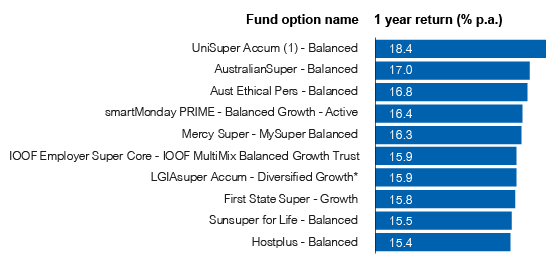
*Interim return
Source: SuperRatings
Top 25 balanced options (return over 10 years)

*Interim return
Source: SuperRatings
UniSuper came out on top in a crowded field, in which the top 10 funds delivered an average return of 16.3%. It was a tight race over longer time periods, and while markets have certainly provided a tailwind, there’s no doubt that skilful management plays a role in squeezing out additional returns.
While returns may appear narrowly spread at the top, this hides some significant differences in asset allocation and investment strategies pursued by different funds. What was interesting to see was the diversity of approaches that funds take, even at the top of the leader board. While most funds have benefited from strong equity markets, the nuances among the top performers are where there has been strong value added for members.
In the case of UniSuper, the fund continues to pursue an active management strategy with exposures predominantly to Australian and International Equities, as well as significant cash and fixed interest exposures. Allocations to illiquid assets such as infrastructure and private equity are not a key component of their strategy.
Meanwhile, Hostplus has significant allocations to illiquid assets, with these being a key driver of its performance outcomes for Property, Infrastructure and Private Equity assets. AustralianSuper has also benefited from material unlisted asset exposures, as well as fee savings generated from its in-house investment structure.
Top pension funds
One of the key challenges super funds face is the current low-yield environment, which is making it harder for funds to generate income for members. This challenge is likely to be felt more acutely by those in the post-retirement phase, who rely on the income generated by their pension product to fund living expenses.
In this environment, picking the right pension fund and option can be critical. The below chart shows how capital stable pension options (20–40% growth assets) stack up over 10 years, and while there is some dispersion in the results, every option in the top 25 by performance exceeded the typical CPI plus 3.0% target. AustralianSuper’s Stable option is the best performer, returning 7.6% p.a. over ten years, followed closely by TelstraSuper’s Conservative option and Hostplus’s Capital Stable option.
Top 25 capital stable pension options (return over 10 years)
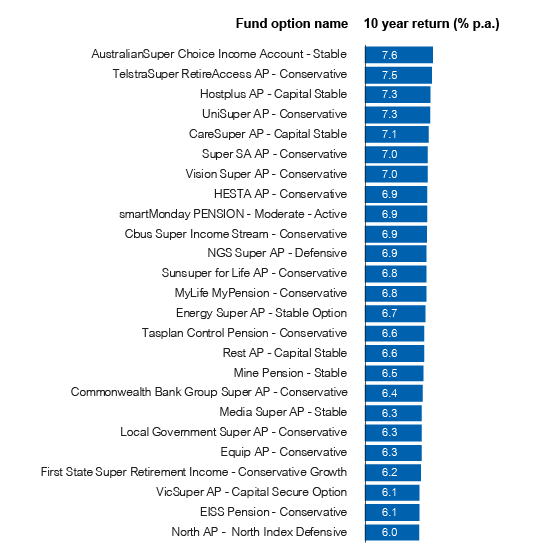
Source: SuperRatings
Understanding risk is critical for consumers
Most consumers can’t define risk, but they know it when they experience it. For superannuation members, risk can mean the likelihood of running out of money in retirement, or not having enough cash to pay for holidays, car repairs, or an inheritance for their kids.
For young members starting out in the workforce, short-term market falls might not matter too much because their investment horizon is relatively long. But for members nearing retirement, the timing of market ups and downs can have a significant effect on the wealth they have available in the drawdown phase.
For a young worker with a relatively low super balance, being exposed to riskier assets is less of a problem – in fact, it can help them accumulate wealth over their working life. However, for members approaching retirement (aged 50 and over), an unexpected pullback in the market can mean the difference between living comfortably and having to cut back in order to get by.
For this reason, it’s important to consider not only the return that a fund delivers but also the level of risk it takes on to achieve that return. In this context, risk means the degree of variability in returns over time. Growth assets like shares may return more on average than traditionally defensive assets like fixed income, but the range of return outcomes in a given period is greater.
The table below shows the top 25 funds ranked according to their risk-adjusted return, which measures how much members are being rewarded for taking on the ups and downs.
Top 25 balanced options based on risk and return
| Fund option name | 7 year return (% p.a.) | Rank |
| QSuper – Balanced | 9.1 | 1 |
| CareSuper – Balanced | 9.8 | 2 |
| Cbus – Growth (Cbus MySuper) | 10.3 | 3 |
| Hostplus – Balanced | 10.5 | 4 |
| BUSSQ Premium Choice – Balanced Growth | 9.6 | 5 |
| Sunsuper for Life – Balanced | 10.0 | 6 |
| Catholic Super – Balanced (MySuper) | 9.4 | 7 |
| HESTA – Core Pool | 9.6 | 8 |
| CSC PSSap – MySuper Balanced | 9.0 | 9 |
| MTAA Super – My AutoSuper | 9.5 | 10 |
| Media Super – Balanced | 9.4 | 11 |
| Intrust Core Super – MySuper | 9.8 | 12 |
| AustralianSuper – Balanced | 10.5 | 13 |
| Mercy Super – MySuper Balanced | 10.0 | 14 |
| Rest – Core Strategy | 9.0 | 15 |
| First State Super – Growth | 9.7 | 16 |
| QANTAS Super Gateway – Growth | 8.3 | 17 |
| TWUSUPER – Balanced | 8.8 | 18 |
| Energy Super – Balanced | 9.3 | 19 |
| Local Government Super Accum – Balanced Growth | 9.0 | 20 |
| AMIST Super – Balanced | 8.9 | 21 |
| VicSuper FutureSaver – Growth (MySuper) Option | 9.8 | 22 |
| Club Plus Super – MySuper | 8.9 | 23 |
| NGS Super – Diversified (MySuper) | 8.9 | 24 |
| LGIAsuper Accum – Diversified Growth* | 8.9 | 25 |
Risk/return ranking determined by Sharpe Ratio
*Interim return
Source: SuperRatings
QSuper’s return of 9.1% p.a. over the past seven years is slightly below the average of 9.7% across the top 10 ranking funds, but it has the best return to risk ratio of its peers, meaning it delivered the best return given the level of risk involved. Funds such as CareSuper, Cbus and Hostplus were able to deliver higher returns, but for a slightly higher level of risk.
Real estate offers potential diversification away from traditional stocks and bonds, stable income, the possibility of capital appreciation and has historically offered inflation protection. The average Australian retiree is likely to have exposure to domestic residential real estate – through the family home, an investment property or holiday home – but these assets are likely concentrated in geography and in the residential sector. Commercial real estate can present geographic diversification to the US, Asia and Europe, and sector diversification into offices, shopping centres and industrial parks. The following article explores the investment choices for the commercial real estate asset class across the risk/return spectrum.
- Real estate may provide investors with the potential to generate attractive long-term returns through possible asset appreciation and current income
- Real estate also may serve as a hedge against inflation and offer diversification versus traditional stocks and bonds
Anyone who has purchased a home is a real estate investor — but there’s a big difference between taking on a mortgage and investing in office buildings, malls or industrial parks. In this blog, we explain the basics of real estate investing, the potential benefits, and the ways that individuals can add real estate exposure to their portfolio.
To find out more about this article, please contact:
Sam Sorace
Director, Wholesale Sales
Invesco Australia
Direct +61 3 9611 3744
Mobile +61 413 050 909
Markets continued their upward trajectory in November. When you look at the returns across key asset classes over the last 12 months most asset classes have generated double digit returns. Growth assets such as equities and listed real assets generated over 20% for the year ending 30 November, while bonds generated high single digit to double digit returns. This has been a great outcome for investors and certainly well above Lonsec’s long-term expected returns for asset classes.
Part of what has fuelled these high returns, post markets getting the wobbles after the US yield curve inverted in August, can be attributed to markets pricing in the avoidance of a recession and the expectations of a potential recovery in growth. We have witnessed such ‘mini-cycles’ in the past, in 2013 and 2016, however what is different this time is that EPS growth is more muted and other factors which contributed to previous mini-cycles, such as the US or Chinese fiscal stimulus, are less likely to have an impact.
So what does this mean for markets? We think markets may experience a short-term upswing as the ‘mini-cycle’ plays out. We have therefore slightly adjusted our dynamic asset allocation tilts deploying some of the excess cash in our portfolios towards Australian equities. Our overall asset allocation continues to have a defensive skew with the objective of diversifying the portfolios by asset type and investment strategy. This positioning reflects our broader view that asset prices are stretched and that while some economic indicators have stabilised, we believe we are closer to the end of the cycle.
Veronica Klaus Head of Lonsec Investment Consulting spoke on a panel at the Professional Planner Researcher Forum in Sydney last week.
Veronica discussed the inconsistency and confusion around asset class definitions, which is one of the biggest issues confronting the industry. The way in which assets are defined as growth, defensive, etc. often lacks transparency and ultimately makes it harder for financial advisers to make the right recommendations for their clients.
However, as Veronica explains, the superannuation funds aren’t necessarily the ones to blame for the problem.
James Syme, Portfolio Manager, Pendal Global Emerging Markets Opportunities Fund
After five tough years, we think the combination of a more benign US monetary outlook and some extremely compelling valuations makes for some powerful opportunities in the emerging market (EM) domestic demand space.
We see domestic demand — the sum of household, government and business spending in an economy including imports but not exports — as the primary area of opportunity in EM, particularly after the 2018 sell-off.
We emphasise an exciting combination of supportive top-down conditions, good quality companies and attractive valuations.
India in favour
India is currently our most favoured market, despite economic growth recently falling to a six-year low.
We like a number of domestic names there including mortgage lenders. Now that the global liquidity outlook has eased, there is the prospect of the Reserve Bank of India continuing to cut rates even as Indian credit growth recovers.
India, unusually in EM, has not had a credit cycle in the last ten years, so the current pick-up in credit could be enduring.
Alongside that, India has ongoing demand for 5-10m residential units per year that need financing.
Mexico and UAE good value
Elsewhere, Mexican equities look markedly cheap relative to history, despite growth being decent, implying some excessively negative market expectations for the political environment.
We also like property stocks in the United Arab Emirates (UAE), particularly in Dubai.
Through its currency peg, the UAE effectively imports US monetary policy. Higher US rates coincided with oversupply of development properties to push real estate prices and related stocks down significantly.
As the Fed’s more accommodative stance improves financial conditions in Dubai, and helped by rising tourist numbers, the prospects for attractively valued Dubai property stocks look good.
South Korea and China
Turning to South Korea, the ongoing corporate governance revolution there is one of the main reasons for our overweight position.
China is a slightly separate story and continues to disappoint.
It has tightened monetary policy significantly in the last two years as the strength of the US dollar has put pressure on the Chinese renminbi, which has been a constraint on the People’s Bank of China’s ability to act.
Activity indicators remain soft, and we think that more stimulus through faster credit creation remains key to a recovery in China.
We’re bullish about:
• The EM domestic demand space offers an exciting combination of supportive top-down conditions, good quality companies and attractive valuations
• A more benign US monetary policy outlook
We’re bearish about:
• Potential for escalation in the US / China trade conflict
• Chinese growth continues to disappoint
Why allocate to Emerging Markets?
As cash rates head below 1%p.a. in Australia, the need for returns from growth assets to offset lower returns from income assets becomes very important for retirees. However in terms of portfolio construction, trying to improve returns without increasing risk becomes very important, due to the increased concerns of retirees around drawdowns. ‘
We believe that a discrete allocation to Emerging Market equities can assist retiree portfolios to achieve these goals because:
• Emerging markets tend to higher GDP growth than developed markets (DM) – and higher equity market returns (+2.46% pa over 20 years^)
• Despite this, emerging market countries are under-represented in most global equity portfolios
• The different growth profiles between DM and EM bring the benefits of diversification to a global equity allocation, without the need to try and time shifts between them.
Figure 1 demonstrates that a simple 50/50 split between MSCI World and MSCI Emerging Markets would have delivered a significantly higher return, at a very small increase in risk, than a purely developed market portfolio over the last fifteen years.
- Figure 1: Risk-return profile since 1 Jan 2001
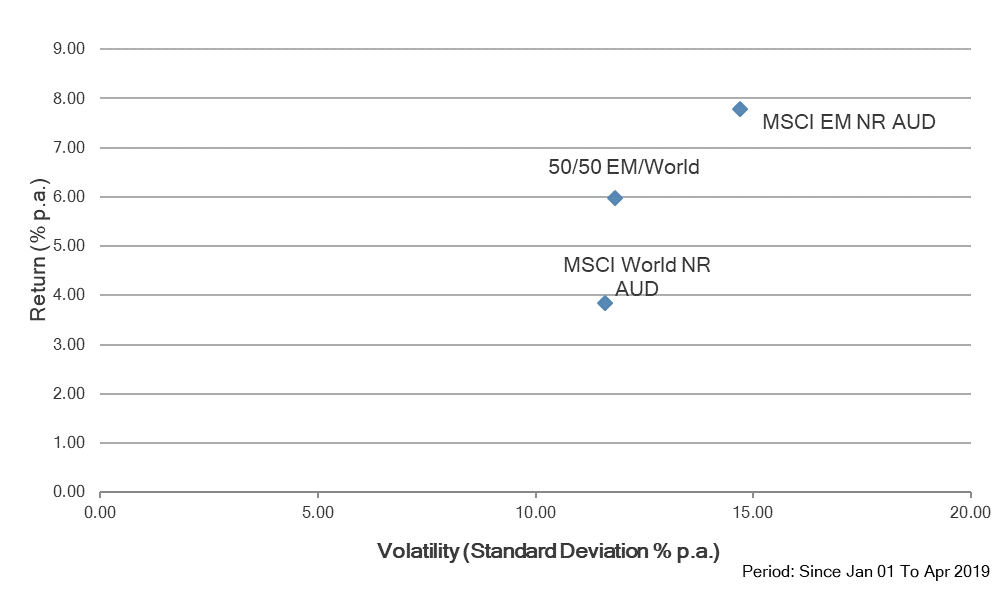
^ Calendar year performance of MSCI World and MSCI EM indices in AUD over 20 years to 31 December 2018.
Hear more about emerging markets as London-based portfolio manager Paul Wimborne of J O Hambro Capital Management presents an update in Sydney and Melbourne in November
Sydney (Nov 14)
Melbourne (Nov 12)
DISCLAIMER
This communication has been prepared by Pendal Fund Services Limited (PFSL) ABN 13 161 249 332, AFSL No 431426 for the exclusive use of advisers and the information contained within is current as at 21 October 2019. It is not to be published, or otherwise made available to any person other than the party to whom it is provided.
PFSL is the responsible entity and issuer of units in the Pendal Global Emerging Markets Opportunities Fund (Fund) ARSN: 159 605 811 (formerly BT Emerging Markets Opportunities Fund). A product disclosure statement (PDS) is available for the Fund and can be obtained by calling 1800 813 886 or visiting www.pendalgroup.com. You should obtain and consider the PDS before deciding whether to acquire, continue to hold or dispose of units in the Fund. An investment in the Fund referred to in this presentation is subject to investment risk, including possible delays in repayment of withdrawal proceeds and loss of income and principal invested.
This communication is for general information purposes only, should not be considered as a comprehensive statement on any matter and should not be relied upon as such. It has been prepared without taking into account any recipient’s personal objectives, financial situation or needs. Because of this, recipients should, before acting on this information, consider its appropriateness having regard to their or their clients’ objectives, financial situation and needs. This information is not to be regarded as a securities recommendation.
The information in this communication may contain material provided by third parties, is given in good faith and has been derived from sources believed to be accurate as at its issue date. While such material is published with necessary permission, and while all reasonable care has been taken to ensure that the information in this communication is complete and correct, to the maximum extent permitted by law neither PFSL nor any company in the Pendal group accepts any responsibility or liability for the accuracy or completeness of this information.
Where performance returns are quoted “After fees” then this assumes reinvestment of distributions and is calculated using exit prices which take into account management costs but not tax you may pay as an investor.
Many behavioural studies have shown there are several traits and biases that can impede us from making reasonable decisions about everything from what to eat to how to invest. Understanding these biases and considering whether they may be negatively impacting decisions can be beneficial when implementing long-term investment plans. These studies show, in general, people have asymmetric risk profiles and fear losses more than the expectation of gains by at least a 2:1 margin[1]. Interestingly, and perhaps not surprisingly, this ratio increases substantially as people approach retirement.
American psychologist and economist, Daniel Kahneman, who won a Nobel Prize for his work challenging the prevailing assumption of human rationality in modern economic theory has stated, ‘If you have an individual whose objective is to maximise wealth at a certain future point in time, then loss aversion is very bad because loss aversion will cause that individual to miss out on many opportunities.’
This loss avoidance trait stands in contrast to a basic investment principal, that investors need to accept higher risk (and higher potential for near-term losses) in order to achieve higher returns over the long term, particularly during market sell-offs. When faced with losses, rational decision-making can become impaired by the emotional desire to avoid more losses.
There are a wide range of cognitive biases that can impact retirement plans, some are listed below:
Confirmation bias
Confirmation bias is the natural human tendency to seek information that confirms an existing point of view or hypothesis. This can lead to overconfidence if investors keep seeing data that appears to confirm the decisions they have made. This overconfidence can result in a false sense that nothing is likely to go wrong, increasing the risk of being blindsided when something does go wrong.
Information bias
Information bias is the tendency to evaluate information even when it is useless in understanding a problem or issue. Investors are exposed to an array of information daily, and it is difficult to filter through this and focus on the relevant information. In general, investors would make superior investment decisions if they ignored daily share price movements and focused on prices compared to the medium-term prospects for the investments. By ignoring daily share price commentary, investors would overcome a dangerous source of information bias in the investment decision making process.
Loss aversion bias
Loss aversion is the tendency for people to strongly prefer avoiding losses than obtaining gains. The loss aversion effect can lead to poor and irrational investment decisions, where investors refuse to sell loss-making investments in the hope of making their money back. Investors fixated on loss aversion can miss investment opportunities by failing to properly consider the opportunity cost of their investments.
Anchoring bias
Anchoring bias is the tendency to rely too heavily on, or anchor to, a past reference or one piece of information when making an investment decision. For example, if you were asked to forecast a stock’s price in three months’ time, many would start by looking at the price today and then make certain assumptions to arrive at a future price. That’s a form of anchoring bias – starting with a price today and building a sense of value based on that anchor.
How do we try and overcome the biases when building retirement portfolios?
The objective based nature of Lonsec’s Retirement portfolios means there is a greater focus on absolute rather than relative performance. Additionally, the portfolios have been constructed to manage risks, including:
- Market and sequencing risk
- Inflation risk
- Longevity risk
Some investment strategies that can assist in controlling for these risks include:
Variable beta strategies can vary equity market exposure by allocating to cash in periods where equity market opportunities are perceived to be limited due to expensive valuations, or where market downside risk is considered high.
Long / Short – Active Extension (also known as 130/30 funds) utilise a broad range of strategies including short selling and adjusting the net equity position for performance enhancement, risk management and hedging purposes.
Multi-asset real return funds invest in a wide range of asset classes, with the managers having considerable flexibility in the type and percentage of asset classes allocated to. Typically, these funds will seek to limit downside risk, while also targeting a real return i.e. a CPI + objective.
Real assets such as property and infrastructure, commodities and inflation linked bonds can assist in managing against inflation risk.
When constructing the Retirement portfolios, Lonsec takes a building block approach by assigning a role for each fund – yield generation, capital growth and risk control.
The yield component of the portfolios generate yield, or a certain level of income from investments that have differing risk return characteristics. The capital growth component is designed to generate long term capital growth, with limited focus on income, and is more suited to early retirees. The risk control component is critical for retirement portfolios and is designed to reduce some of the market risks in the yield and capital growth components. It is important to note that the risk control part of the portfolios will not eliminate these risks but aims to mitigate them. Asset allocation and diversification are also important ingredients in managing the overall volatility of the portfolios.
The Retirement portfolios can assist in managing the risks that impact retirees, however it is important to note that none of these strategies provide a guaranteed outcome. The range of products that offer certainty of income or capital protection such as annuities has increased in recent years, in recognition of Australia’s aging demographics and demand for greater certainty in retirement. Separate guidance on the use of annuities is available from Lonsec.
[1] Gachter, Johnson, Herrmann (2010). Individual – level loss aversion in riskless and risky choices. Columbia Business School
One of the most common investment pitfalls is to back the current winner. All too often investors pile into the best performing share, asset class or fund manager over the past year in the hope that its success will be repeated. This type of naïve momentum strategy can pay off in the short term, but investors quickly find that prior successes are not so easily replicated.
Very rarely does this kind of momentum strategy hold up in the world of managed funds, even over relatively short periods of time. For example, looking at three-year rolling returns for global growth managers, it’s clear that performance can get shuffled around a lot. Those who have outperformed over the previous three years can easily find themselves near the bottom of the pack over the next three years. Equally, those languishing near the bottom can suddenly find themselves out in front of the pack.
Following the winner can make you a loser: Global growth manager return rankings (2016 versus 2019)
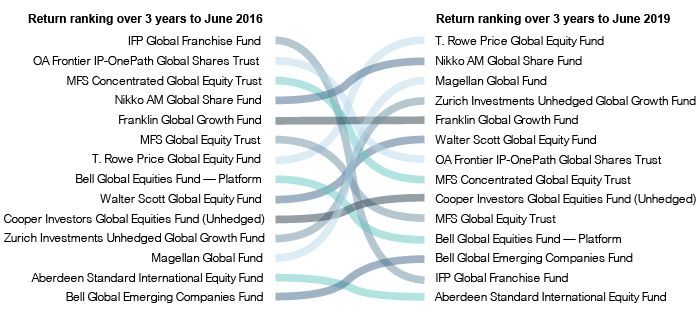
Source: iRate
Obviously, if your manager research is focused on performance, you need to take a long-term view. The challenge, however, is that your analysis will inevitably be limited to those managers who have built up a sufficient track record. There’s also the classic survivorship bias problem: researchers tend to focus on the performance of those funds that have managed to remain in existence over their period of analysis. For active managers, medium- and long-term market dynamics can also have a significant impact on performance. For example, there will be periods when the market favours growth managers and periods when it favours value managers. Just because growth has outperformed value over the past decade doesn’t mean it will continue to outperform in the next. A change in market fundamentals can upend even the most thoroughly researched investment theses.
This all creates a significant conundrum for quantitative research. While qualitative research methods are sometimes criticised for being subject to arbitrary rules, in fact it’s the opposite that proves the case. Determining which quantitative metrics are relevant for which managers over which timeframe is difficult to do with a high degree of precision or confidence. Determining which are the main predictors of future performance is nigh impossible.
So how do successful researchers overcome this challenge? Clearly, quantitative measures are essential in assessing which funds are capable of delivering on their investment objectives. But they are far from the only measures that should inform your investment decisions. Qualitative factors should ideally make up the bulk of your research, but they tend to play a back-seat role because gathering the qualitative intelligence required to pick successful managers is a resource-heavy, time-consuming task. This can result in its own form of selective bias, where researchers focus on those factors that are relatively easier to measure and compare.
The limitations of quant-only research
Selecting the right manager involves looking at more than just past performance. It’s about delivering future outperformance based on an in-depth assessment of individual investment teams. This means understanding how people, strategies, and capabilities come together to position fund managers for success. When it comes to selecting for future success, qualitative research is not merely a filter or a heuristic, it’s the backbone of your entire research process.
While you might be able to get away with poor manager selection when the bull market is raging, the real test comes when the market reaches a turning point. Given the troubling signals from financial markets over the past six months, this is something many investors are starting to take very seriously. Market turning points pose a real challenge for fund managers and have a way of pushing their process and discipline to their absolute limit. In times like these, product recommendations and manager selection really count, and advisers can quickly find their own processes exposed when things go wrong.
Identifying future outperformance is an artform, not a science. Lonsec’s entire research process is built around understanding the range of qualitative factors that determine manager success and giving advisers the tools to select investment products based on individual client needs. Our analysis is based on an onsite assessment of investment teams, combined with a rigorous peer review process that safeguards the quality and integrity of our investment product ratings. Looking back over the past 10 years, our qualitative process has proven its worth. Lonsec’s Recommended and Highly Recommended managers have outperformed their respective benchmarks, even during a period where the long-running beta rally has pushed passive investment strategies ever higher, casting shade on many active managers who have struggled to offer value in this environment.
Performance of Australian equity managers rated Recommended or higher by Lonsec
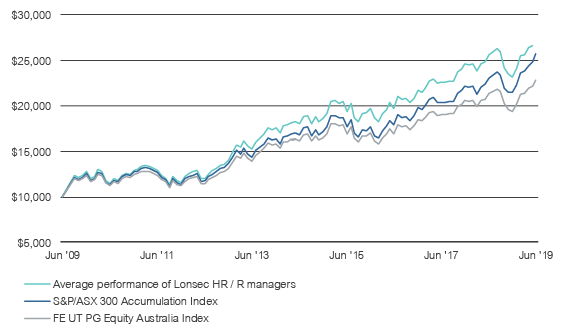
Performance of global equity managers rated Recommended or higher by Lonsec
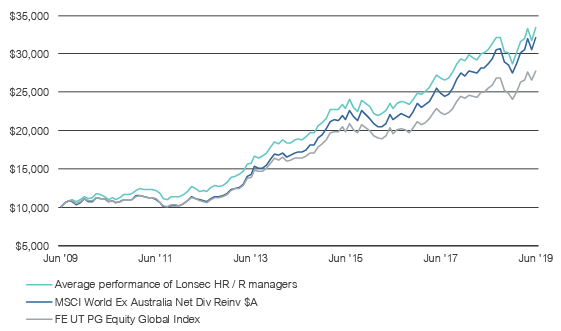
Source: iRate. Average performance is calculated based on historical monthly performance of managers currently rated.
Despite the fact that some active managers struggle to beat the market, we know that there are some that can consistently outperform. But identifying them has little to do with their past performance and much to do with having the right people, resources and processes in place to deliver on their mandate. Looking back through history, there have been funds that have been highly successful, producing people who went on to found their own funds and enjoy similar success. For new funds and products entering the market, there’s often no track record to speak of, meaning qualitative factors are the only means to measure the likelihood of success. If you screen these products out simply because you don’t have enough performance data, you risk missing out on new innovations and strategies that could prove highly valuable.
People and resources
Arguably the most important factor to consider when assessing a fund is the people responsible for making the investment decisions. Your research should take into account the size of the team, its quality, its stability, and its key person risk. Is the team large enough to carry out its mission? Does its analysts have the right level of experience and a track record of success working together? Is the fund overly reliant on a single person whose departure could adversely affect the fund’s performance?
Your research should also examine the culture and structure of the fund. Does the investment team demonstrate a real passion for investing? Do they treat it as a business or a profession? Do they have a stake in the fund’s long-term performance?
Investment philosophy
One of the most telling tests of a fund manager’s capability is to ask them to explain their investment philosophy as simply and concisely as they can. A fund’s investment philosophy should not be a string empty words displayed on the manager’s website and then largely forgotten. An effective philosophy is regularly consulted to ensure that all investment decisions ae consistent with the fund’s purpose. Your research should examine the fund’s philosophy to see if it is consistent and lived out through its investment decisions.
Is the manager sticking closely to its mandate or is it stretching it too far? Is it remaining true to label and delivering on investors’ expectations, or could it end up surprising investors when the market turns? Does the manager exercise patience and buy/sell discipline, or are they liable to panic? While this is fundamentally a qualitative research exercise, this is one example where quantitative research can play a crucial supporting role. For example, Lonsec considers key valuation metrics, performance across differing market conditions, and output from style research tools using holdings-based style analysis software.
Research process
Once the soundness of the investment philosophy has been established, the next step is to ensure that the fund has a robust process in place to identify securities and incorporate them in their portfolio. This involves everything from the idea generation process to the intellectual property and software used to value assets. If the size of the manager’s investable universe is very large, what process do they have for narrowing down their list of potential opportunities? What attributes are they looking for when searching for the right stocks, bonds or properties?
What macro or market themes are they looking to take advantage of? How do they carry out their fundamental analysis and what valuation methods do they use? Do their people and systems have the appropriate breadth and depth to carry out their research process? Lonsec typically requests that managers explain multiple investment theses as a means of demonstrating the investment process at work and gauging consistency with the fund manager’s stated investment style and objectives.
Partnering with a research house to achieve in-depth qualitative research at scale
Developing an effective qualitative research model requires a lot of work, but the real challenge is in supporting the process with the right people and resources. Most investors don’t have the data or the capabilities to be carrying out in-depth qualitative research at scale, which is why they partner with a research house like Lonsec. For investors committed to generating long-term outperformance, a world class research effort is required to be able to identify and evaluate those managers that can generate consistent outperformance from the thousands of managers out there.
Using alternative investment to address pre- and post-retirement issues
Walter Davis, Alternatives Investment Strategist
Ashley O’Connor, Investment Strategist, Invesco Australia
Introduction
Investing in financial markets requires investors to balance return and risk, short-term and long-term goals, and cyclical and structural factors. To do so effectively, investors must also balance the human emotions of greed and fear. Greed drives investors’ desire to build wealth by seeking investments with attractive return potential, while fear drives investors’ desire to avoid losses by investing in low risk investments.
These two emotions are particularly acute for individual investors who have identified (and become emotionally attached to) a specific goal for their savings, be it retirement, funding a college education or buying a house. In such situations, investors want to ensure they generate attractive returns on their investments so they have sufficient wealth to fund the event, while at the same time avoiding damaging losses that could permanently impair their ability to do so. This issue is even more complicated for investors seeking to provide for a comfortable retirement, given the significant variables involved (such as the unknown duration of retirement and highly variable expenses) and the potentially devastating consequences of failure to achieve the goal.
This challenge is not limited to individual investors. Institutional investors, such as defined contribution pension plans, defined benefit pension plans, insurance companies and government-sponsored retirement plans, all face a similar dilemma. In many cases, these investors have plans that are underfunded and need to generate strong returns to meet future liabilities, while at the same time avoiding losses that would undermine their ability to do so.
In technical terms, the two primary risks that these individual and institutional investors face are longevity risk and sequencing risk. Translated, longevity risk is the risk of living longer than your savings last, while sequencing risk is the risk of large negative returns occurring at a time that makes losses difficult to recoup.
The solution to longevity risk is to seek investments that offer attractive return potential in order to help build sufficient wealth to fund retirement. Conversely, the solution to sequencing risk is to seek stable, low-risk investments in order to avoid potentially devastating losses that could permanently impair the investor’s ability to fund retirement. The challenge for investors is to build a portfolio that balances these competing needs.
This paper will explore the issues and challenges associated with longevity and sequencing risk, especially in the current market environment, and examine how alternative investments offer investors potential solutions for these risks.
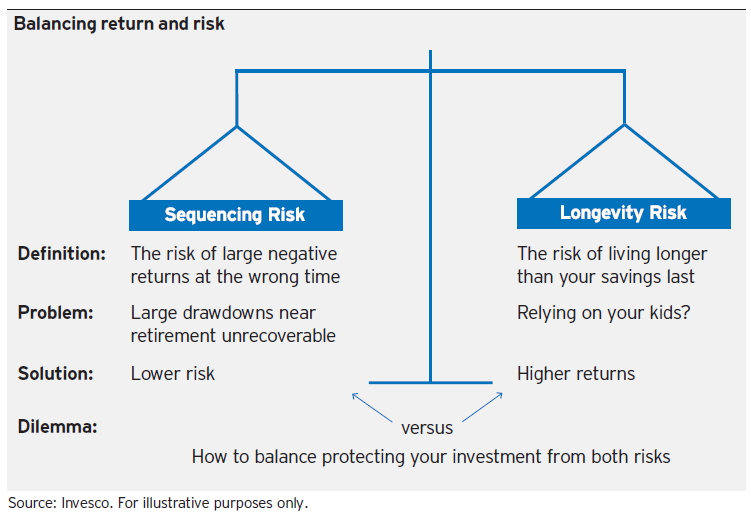
Longevity risk
While longevity risk can be simply explained as the risk of living longer than your savings last, this risk is exacerbated by the fact that many of the variables associated with this risk are unknowable. For example, no one knows how long they or their spouse will live, or whether or not they will face unexpected costs in their retirement.
In 2011, the National Institute on Aging, National Institutes for Health, US Department of Health and Human Services, and World Health Organisation produced a report entitled Global Health and Aging. Several of the key findings of the report illustrate the complex and changing nature of longevity risk.
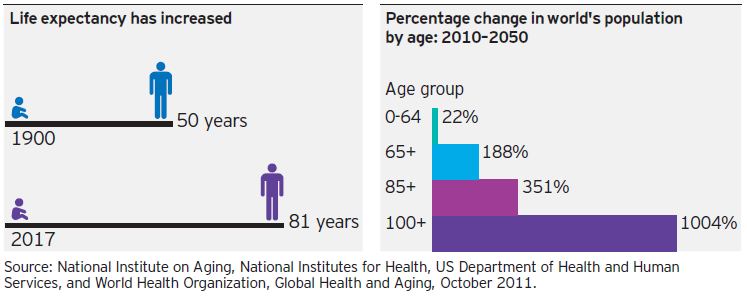
The challenges associated with longevity risk have implications not just for individuals and families trying to save for retirement, but also for society, governments, defined benefit pension plans, defined contribution pension plans and insurers. Specifically, the individuals and entities charged with helping people save for retirement need to ensure that they are doing two things: 1) saving and investing a sufficient amount, and 2) earning a return on their investments that enables them to have sufficient assets to afford retirement.
Unfortunately for investors, the ability to achieve attractive returns has been hindered by the fact that equity returns have declined sharply since 2000 on a global basis. Using the US as an example, in both the 1980s and 1990s, the S&P 500 generated an annualised return of over 17%.1 Between 2000 and 2010, however, equities experienced two bear markets and posted a negative annualised return of less than -1%1 for the decade. Since 2010, equity returns have rebounded, generating an annualised return of over 13%,1 through May 2017. For the period since 2000, equities have achieved an annualised return of just under 5%,1 well below the returns achieved in the 1980s and 1990s. As a result of declining equity returns, the returns achieved in the classic 60% stock, 40% bond portfolios have similarly declined, as shown in the chart below. While this example focuses on the US, the story of falling returns is consistent globally as most developed economies have experienced similar declines in returns.
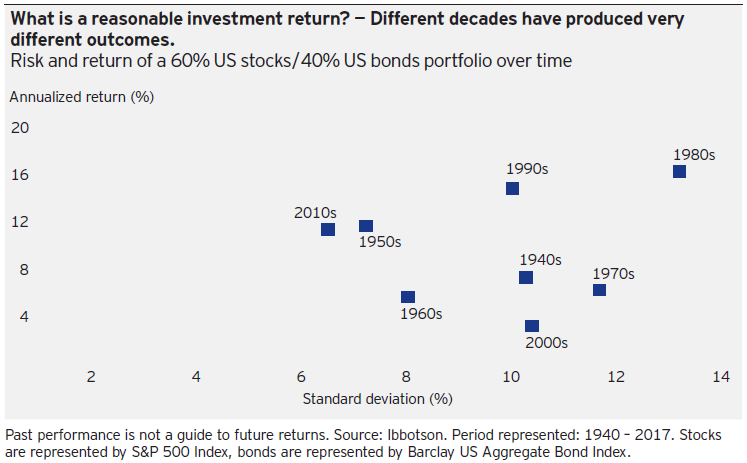
Just as equity returns have declined, so too did interest rates as central banks responded to the Global Financial Crisis by drastically cutting rates in an attempt to support the markets and economy. In some parts of the world, interest rates have turned negative, causing investors to pay for the safety of low-risk investments. The current low level of interest rates, which can be seen in the below chart2, has dramatically impaired investors’ ability to earn an attractive yield on lower-risk assets.
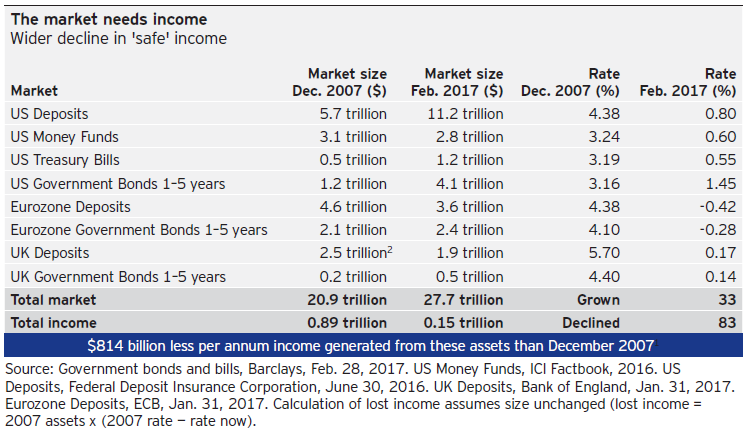
While the decline in interest rates accelerated after 2000, interest rates have steadily been declining over the past 30 years as bonds have enjoyed a historic bull market. Again using the US as an example, during the 1980s the yield on 10-year US government bonds ranged between approximately 7% and 10%.3 In the 1990s, yields declined but remained attractive, ranging between approximately 5% to 8%.3 In the 2000s, yields fell further and generally ranged between approximately 2.5% and 5%.3 Since 2010, yields have often fallen below 2% and today yield approximately 2.3%.3 The US experience with falling rates is broadly consistent with the experiences of other developed economies around the globe.
Taken collectively, an investor saving for retirement faces the following challenges related to longevity risk:
The need to fund a retirement of unknown duration, which could last far longer than expected due to increasing life expectancy
The risk of increased expenses and medical costs in retirement due to illnesses associated with extended life expectancy, such as dementia
A prolonged period of modest equity returns and low yields on low-risk government bonds.
In order to address this risk, there are two steps that investors can and should take: 1) increase the amount of money being set aside for retirement, and 2) seek to prudently increase the return potential of the portfolio. As the chart below illustrates, even modest increases in return can significantly improve an investor’s ability to fund retirement.
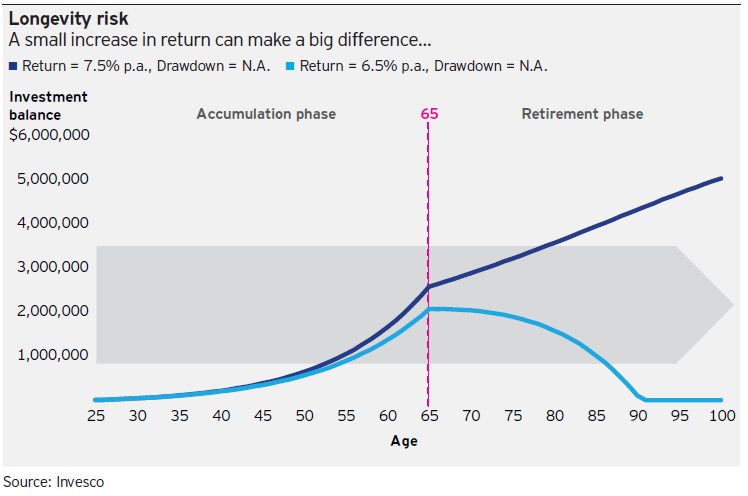
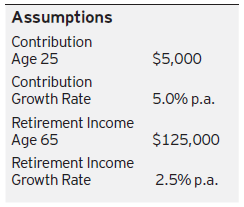
Sequencing risk
Sequencing risk is the risk of large losses occurring in a portfolio at a time when it is difficult to recoup them. For example, a 45-year-old who incurs large portfolio losses has 20 years before reaching the retirement age of 65, and therefore has a long time horizon over which to recover. The situation is very different when a 65-year-old incurs large losses in their first year of retirement. This also tends to be when an investor has the greatest amount of invested wealth during their life to date, making them more vulnerable to large losses. Such losses can force the retiree to return to the workplace and/or may require a more limited retirement than planned.
A primary reason that losses are such a concern to investors is that after a loss is incurred, the investor must achieve a return greater than the percentage of the loss in order to recoup the loss. This is due to the fact that the losses reduced the size of their portfolio and thus require a higher return to offset the smaller portfolio size. This point is illustrated in the diagram below;
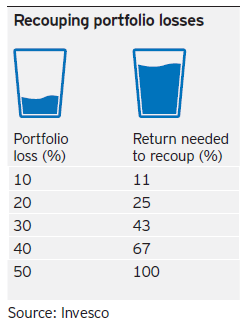
For example, if an investor loses 50% on a $100,000 portfolio, the size of the portfolio shrinks to $50,000. The investor must then achieve a 100% return on the remaining $50,000 portfolio in order for the portfolio to return to its pre-loss size of $100,000. The larger the size of the loss, the greater return, and the longer it will take, to recover the losses. The impact of such losses on an investor is highlighted in the chart below.
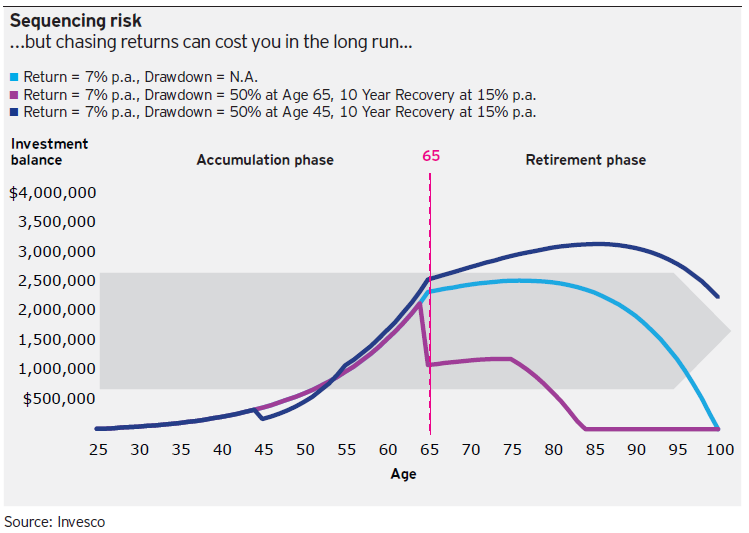

When building a portfolio, volatility and risk of loss should always be a primary focus of investors, as market downturns occur more regularly than many investors realise. Many investors, however, have short memories and discount the potential risk of incurring outsized losses, despite several historical examples of large market declines, as shown below:
- Dow Jones Industrial Average (DJIA) — In 1929, the Dow hit an all-time high of 381.17, before declining 89% to 41.22 in 1932. It took until 1954, a period of 25 years, before the index achieved a new peak.3
- DJIA — On October 19, 1987, the DJIA declined 22.6%, the largest one-day decline (in percentage terms) in its history. It took 15 months for the index to return to pre-crash levels, and 24 months for it to hit a new peak.3
- Japanese Nikkei — The Nikkei hit an all-time high of 38,916 on December 29, 1989. As of May 31, 2017, the Nikkei sat at 19,650, approximately 50% below its all-time high.3
- NASDAQ — On March 10, 2000, the NASDAQ hit a record high of 5048.62 before declining approximately 80% by October 2002. It took 15 years for the index to achieve a new peak.3
- S&P 500 — The S&P 500 hit a then record high of 1565.15 on October 9, 2007. From that lofty level, the index declined 56.8%, due in large part to the Global Financial Crisis, hitting a low of 676.53 on March 9, 2009. Over five years later, in March 2013, the index achieved a new peak.3
In order to mitigate sequencing risk, investors have long been counselled to reduce the risk of their portfolios as they age by shifting away from stocks toward bonds and cash equivalents. A common rule of thumb for investing was to subtract the investor’s age from 100 to determine how much to invest in stocks, with the remaining balance being invested in bonds and cash equivalents. Under this rule of thumb, a 30-year-old would invest 70% of their portfolio in stocks, while a 65-year-old would invest 35% in stocks. This same general principal can be seen in target date funds, as these funds typically reduce the risk exposure of the portfolio the closer they get to the target date.
This approach works well for the select few investors and pension plans that have comfortably funded their retirements and plans, but presents a challenge for investors who are dealing with underfunding or issues related to longevity risk. Furthermore, this approach worked much better for investors in the higher return era of the 1980s and 1990s, when equities achieved annualised returns of 17% and 10-year US government bonds yielded 5% to 10%.1 Since 2000, however, it has become much more challenging with equities having achieved annualised returns of less than 5% and 10-year US government bonds yielding between 2 and 3%.3 Additionally, investors in bonds may potentially face a bear market when interest rates inevitably increase from their current low levels.
The investment strategy of steadily reducing risk over time involves a clear return and risk trade-off. Specifically, by decreasing the allocation to equities and increasing the allocation to cash and bonds, investors are reducing the return potential of their portfolios in order to decrease the risk of their portfolio. This approach helps the investor address sequencing risk, but potentially exacerbates the investor’s longevity risk.
Balancing longevity risk and sequencing risk
Just as investors need to balance greed and fear, they need to strike a balance in addressing longevity risk and sequencing risk. Longevity risk pushes investors to invest in riskier assets in order to achieve higher returns and grow their portfolios, while sequencing risk does the opposite and pushes investors to increase their exposure to low-risk assets in order to reduce the risk of losses. Addressing the conflicting nature of these risks is critical, and extremely challenging, for investors.
While there is no magic solution to this issue, investors’ ability to balance these competing risks can potentially be improved by looking beyond traditional investments in stocks and bonds and considering alternative investments.
Alternatives have the potential to provide investors with unique return and risk characteristics that can help them address the issues of longevity and sequencing risk. Specifically, there are some types of alternatives that have the potential to address longevity risk by generating returns equal to, or greater than, equities, or generating current income well above that of bonds. There are other types of alternatives that have the potential to address sequencing risk by offering investors downside protection and volatility reduction. Lastly, there are some types of alternatives that can help investors simultaneously address both longevity and sequencing risk by generating equity-like returns with lower volatility and lower drawdowns than equities.
What are alternative investments?
While there is no one common definition for alternative investments, Invesco defines alternatives as investments other than publicly traded, long-only equities and fixed income. Based on this definition, investments that have any of the following characteristics would be defined as alternative investments:
- Investments that invest in illiquid and / or privately traded assets, such as private equity, venture capital, and private credit.
- Investments that engage in “shorting” (i.e., seeking to profit from a decline in the value of an asset), such as global macro, market neutral and long / short equity strategies
- Investments in asset classes other than stocks and bonds, such as commodities, natural resources (i.e. timberland, oil wells), infrastructure, master limited partnerships (MLPs), and real estate.
(Please note that the above definition is intentionally broad and inclusive. Different investor types often have their own unique definition of alternatives and may classify specific investment types differently.)
Alternatives can be broadly categorised as liquid or illiquid. Liquid alternatives predominantly invest in underlying instruments that are frequently traded and regularly priced, and provide investors with the ability to redeem their investment on a regular basis, be it daily, monthly or quarterly. Alternative mutual funds, alternative Undertakings for the Collective Investment of Transferable Securities (UCITS) funds and most traditional hedge funds are examples of liquid alternatives. Alternative mutual funds and UCITs are available for investment by retail investors, high net worth investors (i.e., individuals with a net worth in excess of $5 million) and institutional investors (i.e., pension plans, foundations, endowments and sovereign wealth funds). Traditional hedge funds, however, are typically only available to high net worth and institutional investors.
Illiquid alternatives predominantly invest in underlying instruments that are privately traded, priced on a periodic basis (often quarterly) and require investors to hold the investment over a prolonged period (typically several years) with little to no ability to redeem the investment prior to its maturity. Private equity, venture capital, direct real estate, private credit, direct infrastructure and natural resources are examples of illiquid alternatives. The availability of illiquid alternatives varies from country to country and is dependent on each countries individual regulatory environment. Generally speaking, illiquid alternatives are typically only available to institutional investors and high net worth individual investors, and are not typically available to retail investors.
When looking at alternatives, Invesco divides the universe into two baskets: alternative asset classes and alternative investment strategies:
- Alternative asset classes are investments in asset classes other than stocks and bonds. Investments in real estate, commodities, natural resources, infrastructure and MLPs are all examples of alternative asset classes. Alternative asset classes can be accessed through either liquid or illiquid investments. Examples of liquid alternative asset investments include investing in real estate through REITS, investing in the equity and / or bonds of publicly traded infrastructure companies, or investing in commodities by using futures. Examples of illiquid alternative asset investments include direct, private market investments in real estate, natural resources, and / or infrastructure.
- Alternative investment strategies are investments in which the fund manager is given increased flexibility with how to invest. The manager is often given the ability to trade across multiple markets and asset classes such as stocks, bonds, currencies and commodities, as well as given the ability to short markets. Common hedge fund strategies such as global macro, long / short equity, market neutral, managed futures and unconstrained fixed income are all examples of alternative strategies.
Strategies such as global macro, market neutral, long / short equity, and managed futures all typically invest on a long and short basis. The ability to short has the potential to significantly impact the return stream of these investments, as shorting gives these strategies the potential to generate positive returns in a falling market environment. At a minimum, the use of shorts provides these strategies with a powerful tool to potentially limit losses during such an environment.
Additionally, alternative investment strategies often are frequent users of derivatives, such as futures, forwards, options and swaps. While derivatives are often misunderstood and viewed as risky, within the context of alternative investment strategies, derivatives are commonly used to improve portfolio diversification, hedge out market risks, help protect on the downside and efficiently establish market exposure.
Given the myriad alternatives available to investors,4 one of the major challenges for investors is to understand the unique aspects of the various strategies. To help investors navigate this challenge, Invesco has created the below framework that organises the alternatives universe into six unique categories based on an investor’s investment objectives. The first five alternative categories (Alternative Assets, Relative Value, Global Investing and Trading, Alternative Equity and Alternative Fixed Income) represent liquid alternatives, while the sixth alternative category, Private Markets, represents illiquid alternatives.
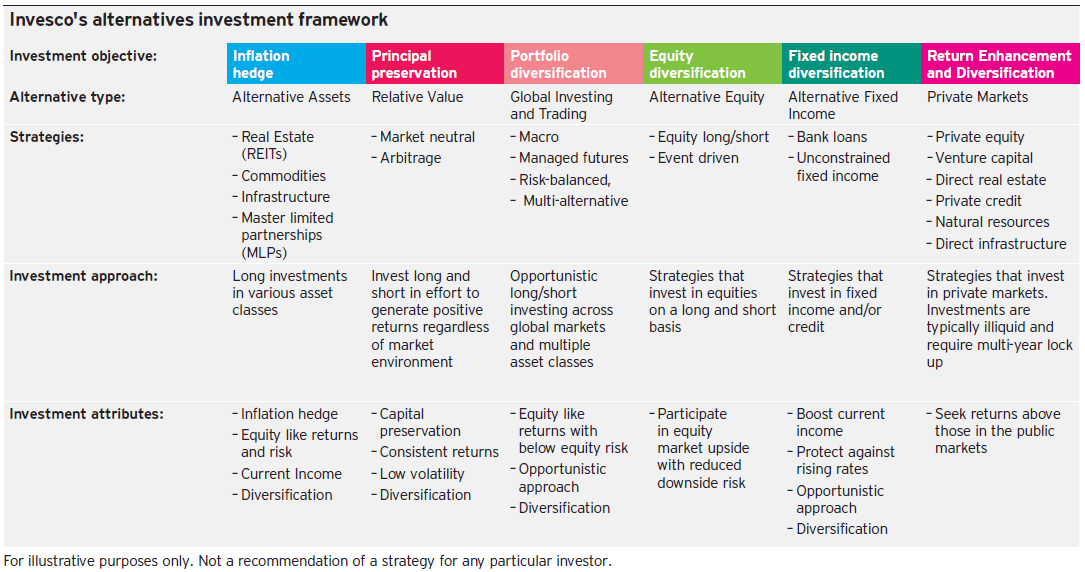
How alternative investments can help mitigate longevity and sequencing risk
The ability of alternatives to help investors mitigate longevity and sequencing risk can be seen when looking at the historical performance of alternatives. To this end, the table below shows the historical performance of the various categories within Invesco’s Alternatives Framework compared to equities (i.e. S&P 500) and fixed income (i.e. Barclay U.S. Aggregate Bond Index). (Please note that the data used for the various categories of the framework reflect quarterly returns rather than monthly returns. While the liquid alternatives categories all have monthly returns available, the indexes used for private markets only report returns on a quarterly basis. In order to ensure consistency, quarterly returns were used.)
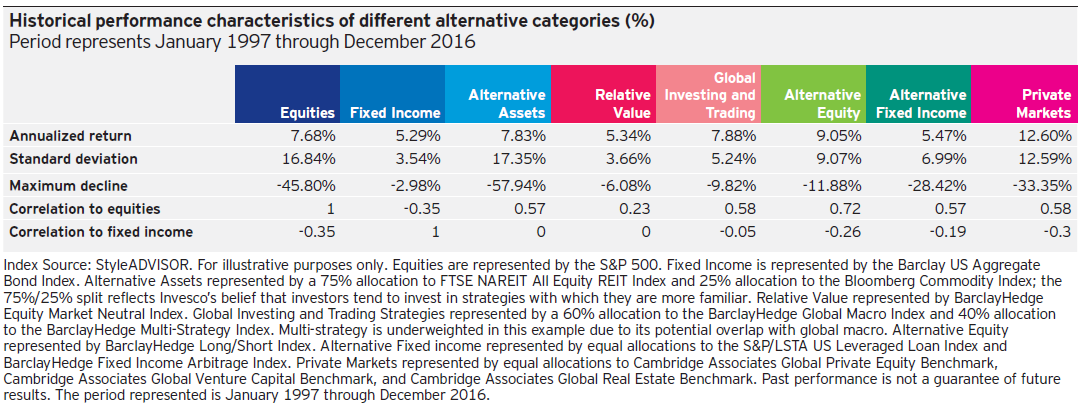
Examining the historical performance of these various alternative categories allows investors to gain a better understanding of the performance characteristics of each category, as well as how different types of alternatives can help address the challenges of longevity and sequencing risk. Based on an examination of the historical performance of the various categories, the chart below illustrates which risks the various alternative categories are best positioned to mitigate:

As a general rule, alternative investment strategies are effective tools to help reduce sequencing risk, while illiquid alternatives are well positioned to help reduce longevity risk. By combining both liquid and illiquid alternatives within a portfolio, investors can simultaneously address both longevity and sequencing risk.
How to implement alternatives into a portfolio to address longevity and sequencing risk
Once investors have made the decision to allocate to alternatives to address longevity and sequencing risk, they then need to decide how best to implement that decision. Invesco believes that the asset allocation process is as much an art as it is a science, and that there is no one-size-fits-all approach. That said, there are key issues that every investor should address when considering adding alternatives to their portfolio. Specifically, investors contemplating adding alternatives to their portfolio in order to meet longevity and sequencing risk should consider the following questions:
- What risk or risks are they seeking to address? Determining the risks an investor is seeking to address will drive the decision as to which alternatives to add to the portfolio. Investors primarily concerned about longevity risk will focus on alternatives that have the potential to deliver returns equal to, or greater than, those of equities. Investors primarily focused on sequencing risk will focus on alternatives that can reduce performance volatility and risk of loss. Finally, investors concerned about addressing both longevity and sequencing risk will focus on those alternatives that can simultaneously address both risks and/or will seek a combination of alternatives that can address each risk individually.
- Which types of alternatives do they have access to? Many liquid alternatives strategies are available to all investors in familiar structures such as mutual funds or UCITs. Private market strategies, however, are typically only available to high net worth and institutional investors.
- What are the risks associated with the alternatives they are considering? As with any investment, alternatives have unique risks associated with them. It is important that investors fully understand all associated risks before investing.
- How much should they invest in alternatives? The percentage an investor allocates to alternatives varies widely. For most investors, a typical allocation to alternatives would range between 5% and 30%. There are several institutional investors, however, such as the Yale Endowment, that allocate over 50% of their portfolio to alternatives.5
- Should the allocation to alternatives be funded from equities or fixed income? The decision of how to fund the allocation varies greatly from investor to investor, and is often driven by the investor’s return and risk objectives for both the portfolio and the investment being considered.
The answers to these questions will significantly impact which alternatives an investor uses, how they incorporate them into their portfolio, their impact on the return and risk characteristics on the portfolio, and subsequently, their effectiveness in addressing longevity and sequencing risk.
To illustrate the potential impact of incorporating alternatives into a portfolio, consider the following scenarios:
- An investor is seeking to address both longevity and sequencing risk.
- The investor’s current portfolio is 60% equities and 40% bonds.
- Retail investors only have access to liquid alternatives (i.e. cannot invest in illiquid alternatives), and allocate evenly across the five liquid alternative investment categories.
- High net worth and institutional investors have access to both liquid and illiquid alternatives, and split their allocation evenly between liquid and illiquid alternatives. These investors opt to gain exposure to alternative assets through direct, private market investments, rather than through liquid alternatives, due to the higher return potential of private market investments. Additionally, their exposure to liquid alternatives is evenly allocated across the liquid alternative investment categories, excluding Alternative Assets given they can access this exposure in direct/illiquid markets.
- To fund their allocation to alternatives, investors allocate proportionally away from stocks and bonds (i.e. a 20% allocation to alternatives will be funded by reducing exposure to equities by 20% and reducing exposure to fixed income by 20%)
- Investors allocate either 20% or 30% of their portfolio to alternatives.
Based on the above assumptions, the chart below illustrates the impact of adding alternatives to a portfolio: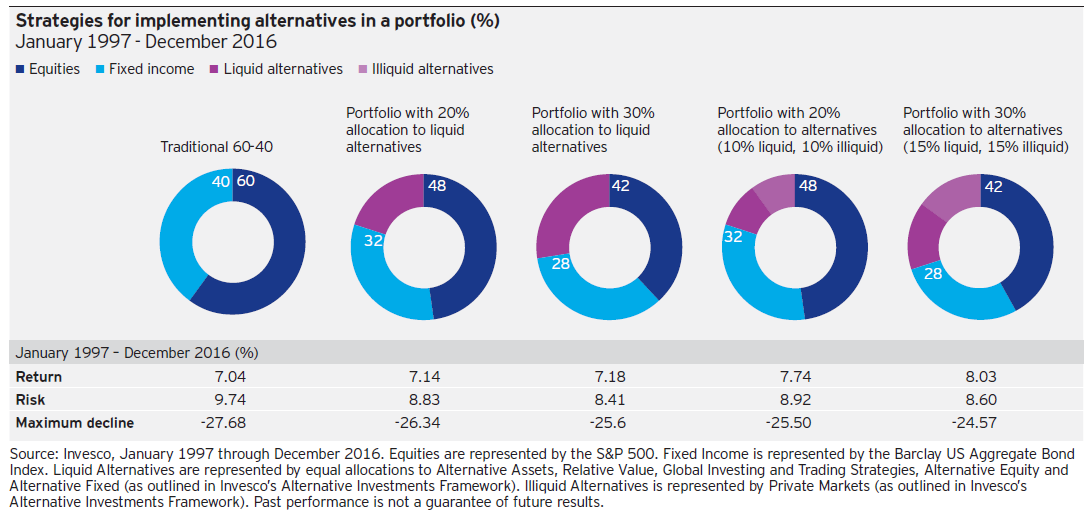
In each of the above cases, an investor seeking to address both longevity and sequencing risk would benefit from higher returns and lower risk by including alternatives in their portfolio. Each portfolio’s compound annual return increased, thus helping the investor address longevity risk. At the same time, both risk (as measured by standard deviation) and maximum decline decreased, helping the investor address sequencing risk.
While the above example is relatively simple, it illustrates how the use of alternatives can help investors address longevity and sequencing risk by simultaneously boosting return and decreasing risk. Furthermore, by thoughtfully deciding which alternatives to allocate to, investors can alter the return and risk characteristics of their portfolios in order to most effectively address their unique needs vis-a-vis longevity and sequencing risk.
Summary
Investors must address the conflicting natures of longevity risk and sequencing risk if they are to invest successfully. These risks are especially acute for individual and institutional investors seeking to provide for a comfortable retirement.
The solution to longevity risk is to seek investments that offer attractive return potential in order to help build sufficient wealth to fund retirement. Conversely, the solution to sequencing risk is to seek stable, low-risk investments in order to avoid potentially devastating losses that could permanently impair the investors’ ability to fund retirement. The challenge for investors is to build a portfolio that balances these competing needs.
While there is no magic solution to this issue, investors’ ability to balance these competing risks can potentially be improved by looking beyond traditional investments in stocks and bonds and considering alternative investments.
Alternatives have the potential to provide investors with unique return and risk characteristics that can help them address the issues of longevity and sequencing risk. Specifically, there are some types of alternatives that have the potential to address longevity risk by generating returns equal to, or greater than, equities, or generating current income well above those of bonds. There are other types of alternatives that have the potential to address sequencing risk by offering investors downside protection and volatility reduction. Lastly, there are some types of alternatives that can help investors simultaneously address both longevity and sequencing risk by generating equity-like returns with lower volatility and lower drawdowns than equities.
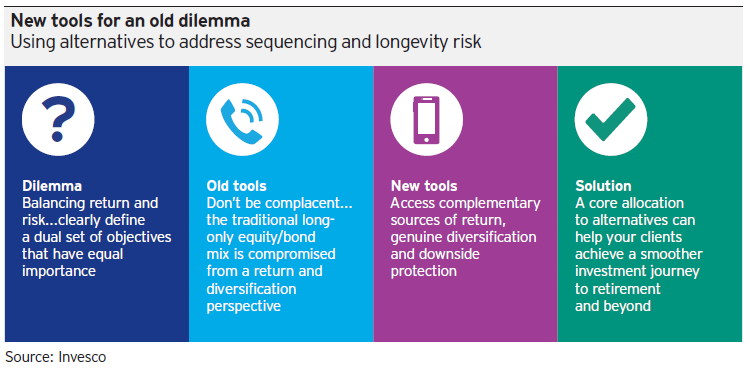
Alternative investments at Invesco
Invesco is a leading provider of alternative investments on a global basis, and believes there are four aspects of its alternatives capabilities that collectively differentiate Invesco from its competitors:
- Proven and experienced portfolio management — Invesco has been managing alternative investments since the early 1980s, and currently has over 350 investment professionals managing over $155 billion in alternative assets.6
- Diverse array of alternatives capabilities and offerings — Invesco’s alternative capabilities span the entire alternatives universe with offerings across all six alternative categories: Alternative Assets, Relative Value, Global Investing and Trading, Alternative Equity, Alternative Fixed Income and Private Markets. Furthermore, Invesco’s offerings are available in a variety of structures, as we understand the importance of delivering offerings in the manner our clients prefer.
- Experience working with retail, high net worth, and institutional investors — Invesco has extensive experience working with and meeting the needs of retail, high net worth and institutional investors. Approximately two-thirds of Invesco’s $858B US in AUM is from retail and high net worth investors, while one-third is from institutional clients.7 Furthermore, Invesco is committed to providing our clients with industry-leading thought leadership on alternatives, in order to help them better understand the unique nature of this asset class and effectively implement alternatives into their portfolios.
- Robust risk management and corporate governance infrastructure — As a global company with a long history, Invesco understands the importance of building a strong risk management and corporate governance structure to support our offerings, including alternatives.
Given the strength of its alternatives capabilities, Invesco is well-positioned to help investors address the issues of longevity and sequencing risk through the inclusion of alternative investments in their portfolios. To learn more about Invesco alternative capabilities and specific offerings, please contact your local Invesco representative or visit our website at www.invesco.com.
1 Source: Zephyr
2 UK 2007 is based on British Banking Association data — discontinued.
3 Source: Bloomberg
4 Alternative investments are subject to various regulatory requirements that vary across the globe. Furthermore, there are often suitability requirements that an investor must meet in order to invest in alternatives. For this reason, not all alternatives may be available to all investors.
5 Source: Yale Endowment 2015 Annual Report
6 As of June 30, 2017.
7 Source: Invesco Ltd. as of March 31, 2017
About risk
Short sale risk. Short sales may cause an investor to repurchase a security at a higher price, causing a loss. As there is no limit on how much the price of the security can increase, exposure to potential loss is unlimited.
Alternative risk. Alternative products typically hold more non-traditional investments and employ more complex trading strategies, including hedging and leveraging through derivatives, short selling and opportunistic strategies that change with market conditions. Investors considering alternatives should be aware of their unique characteristics and additional risks from the strategies they use. Like all investments, performance will fluctuate.
MLP Risk. Most MLPs operate in the energy sector and are subject to the risks generally applicable to companies in that sector, including commodity pricing risk, supply and demand risk, depletion risk and exploration risk. MLPs are also subject the risk that regulatory or legislative changes could eliminate the tax benefits enjoyed by MLPs which could have a negative impact on the after-tax income available for distribution by the MLPs and/or the value of the portfolio’s investments.
Important information
This document has been prepared only for those persons to whom Invesco has provided it. It should not be relied upon by anyone else. Information contained in this document may not have been prepared or tailored for an Australian audience and does not constitute an offer of a financial product in Australia. You may only reproduce, circulate and use this document (or any part of it) with the consent of Invesco.
The information in this document has been prepared without taking into account any investor’s investment objectives, financial situation or particular needs. Before acting on the information the investor should consider its appropriateness having regard to their investment objectives, financial situation and needs. You should note that this information:
- may contain references to dollar amounts which are not Australian dollars;
- may contain financial information which is not prepared in accordance with Australian law or practices;
- may not address risks associated with investment in foreign currency denominated investments; and
- does not address Australian tax issues.
Issued in Australia by Invesco Australia Limited (ABN 48 001 693 232), Level 26, 333 Collins Street, Melbourne, Victoria, 3000, Australia which holds an Australian Financial Services Licence number 239916.
Important information: Any express or implied rating or advice is limited to general advice, it doesn’t consider any personal needs, goals or objectives. Before making any decision about financial products, consider whether it is personally appropriate for you in light of your personal circumstances. Obtain and consider the Product Disclosure Statement for each financial product and seek professional personal advice before making any decisions regarding a financial product.



